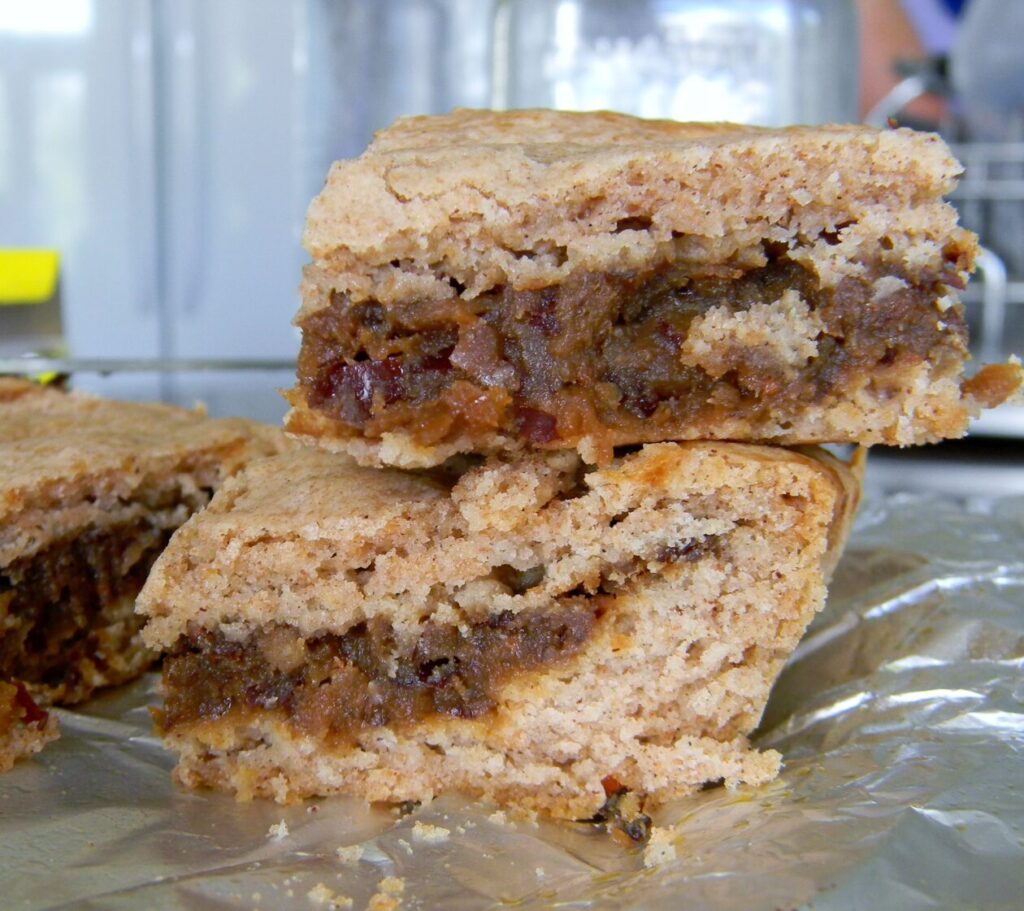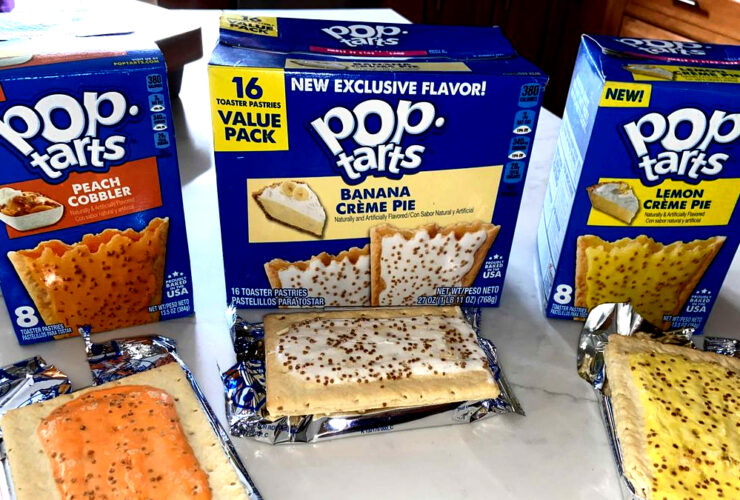Introduction
Fig bars are a popular snack choice praised for their delectable flavor and easy mobility. They typically feature a sweet fig filling inside a soft, chewy crust, offering contrasting textures and flavors. Beyond their appeal as a treat, fig bars have garnered attention for their nutritional composition, attracting those seeking healthier snack options. Made with whole wheat flour, dried figs, oats, and natural sweeteners such as honey or maple syrup, fig bars align with a balanced diet, emphasizing whole foods and minimal processing.
Are Fig Bars Good for Weight Loss? The contribution of fig bars to weight loss can vary depending on individual food choices and lifestyle factors. While fig bars are a nutritious addition to any diet, evaluating their calorie and nutrient content for overall weight loss goals is essential. Ingredients like oats, almonds, and natural sugars contribute to fig bars’ modest calorie density while providing dietary fiber, promoting prolonged satiety, and aiding in weight management. Moreover, the high fiber content of figs supports digestive health, which is crucial for overall well-being and maintaining a healthy weight.
When incorporating fig bars into a weight loss strategy, it’s vital to consider portion sizes and total calorie intake. While fig bars can serve as a quick and filling snack, excessive consumption may elevate calorie intake and hinder weight loss efforts. To enhance the nutritional profile of fig bars, opt for homemade versions or select products with reduced added sugar and healthier fats. Additionally, pairing fig bars with nutrient-dense foods like raw vegetables, Greek yogurt, or fresh fruit can enhance their nutritional value and balance the meal. Practicing moderation and balance when integrating fig bars into a weight loss regimen is key, mirroring the approach to any dietary decision.
Nutritional Composition of Fig Bars
A. Analysis of Ingredients
- Oats and Whole Wheat Flour:
Fig bars typically contain oats and whole wheat flour as primary ingredients. Both oats and whole wheat flour are rich in fiber, which aids in digestion and contributes to feelings of fullness. Additionally, these ingredients provide complex carbohydrates, offering sustained energy release without causing spikes in blood sugar levels.
- Dried Figs:
Dried figs serve as the main component of the filling in fig bars. They are naturally sweet and contain essential potassium, calcium, and iron nutrients. Figs are also high in dietary fiber, which supports digestive health and may help regulate blood sugar levels.
- Maple Syrup and Brown Sugar:
While some fig bar recipes use natural sweeteners like maple syrup or honey, others may include brown sugar. These sweeteners add flavor and sweetness to the bars but should be consumed in moderation due to their high-calorie content. Opting for recipes with less added sugar or alternative sweeteners helps reduce overall calorie intake.
- Coconut Oil:
Coconut oil is commonly used in fig bar recipes as a source of healthy fat. While coconut oil adds moisture and richness to the bars, consuming it in moderation is essential due to its high saturated fat content. Alternatives like unsweetened applesauce or mashed bananas can be used to reduce the fat content of homemade fig bars.
- Spices and Flavorings:
Fig bars are often flavored with spices like cinnamon and nutmeg, which add warmth and depth to their taste profile. These spices enhance the flavor and provide additional health benefits, such as anti-inflammatory properties and improved blood sugar control.
B. Nutritional Benefits
- Fiber Content:
One of the significant nutritional benefits of fig bars is their high fiber content. Fiber aids digestion, promotes feelings of fullness and helps regulate bowel movements. Consuming fiber-rich foods, like fig bars, can support weight loss efforts by keeping you satisfied for longer periods and reducing overall calorie intake.
- Natural Sugars vs. Added Sugars:
Fig bars contain natural sugars from ingredients like dried figs and maple syrup, which provide sweetness without the need for excessive added sugars. Unlike refined sugars, natural sugars come with additional nutrients and fiber, making them healthier for overall health and weight management.
Coconut oil, a common ingredient in fig bars, contributes to their texture and flavor while providing healthy fats. These fats are essential for various bodily functions and can help increase satiety when consumed in moderation. However, it’s crucial to be mindful of portion sizes to avoid excessive calorie intake.
- Micronutrients:
In addition to fiber and healthy fats, fig bars may contain essential micronutrients like vitamins and minerals from ingredients such as dried figs and whole wheat flour. These micronutrients are vital to overall health and well-being, contributing to a balanced diet conducive to weight loss goals.
Here are some key nutrition facts related to fig bars:
- Calories: The calorie content of fig bars can vary depending on the brand and specific recipe. On average, one fig bar contains around 100-120 calories.
- Carbohydrates: Fig bars are primarily composed of carbohydrates, with the main sources being whole wheat flour, oats, and dried figs. Each bar typically contains approximately 20-25 grams of carbohydrates.
- Fiber: Fig bars are a good source of dietary fiber, thanks to ingredients like whole grains and dried figs. A single fig bar can provide around 2-3 grams of fiber, contributing to digestive health and promoting feelings of fullness.
- Protein: While not a significant protein source, fig bars contain a small amount, usually around 1-2 grams per serving. Protein helps support muscle growth and repair.
- Fat: Fig bars typically contain minimal fat, mostly from healthy sources like nuts or coconut oil. The fat content in one fig bar is usually less than 5 grams.
- Sugar: Fig bars contain natural sugars from ingredients like dried figs, honey, or maple syrup. The sugar content can vary, typically around 8-12 grams per serving. It’s essential to check the label for added sugars, as some commercially produced fig bars may contain higher amounts of added sweeteners.
- Micronutrients: Fig bars may also provide small amounts of essential vitamins and minerals, such as iron, calcium, and potassium, depending on the ingredients used in the recipe.
These nutrition facts highlight the overall composition of fig bars and can help individuals make informed choices about including them in their diet, especially when considering weight loss goals.
Fig Bars vs. Store-Bought Options

A. Homemade vs. Store-Bought Fig Bars
Homemade fig bars often boast higher-quality ingredients compared to their store-bought counterparts. When making fig bars at home, individuals have greater control over the ingredients used, allowing them to prioritize whole foods and minimize added sugars and preservatives. In contrast, store-bought fig bars may contain additional additives and processed ingredients to extend shelf life and enhance flavor, which may not align with weight loss goals.
The texture and taste of homemade fig bars can vary significantly from store-bought options. Homemade fig bars tend to have a fresher, more natural flavor with a softer texture resulting from whole ingredients and minimal processing. On the other hand, store-bought fig bars may have a denser texture and a sweeter taste due to added sugars and artificial flavorings. Individuals focused on weight loss may prefer homemade fig bars for their simpler, less processed nature.
B. Considerations for Weight Loss
When comparing homemade and store-bought fig bars for weight loss, it’s essential to consider their caloric content. Homemade fig bars typically have fewer calories per serving since they contain fewer additives and lower amounts of added sugars and fats. By controlling portion sizes and ingredient choices, individuals can better manage their calorie intake while enjoying homemade fig bars as part of a balanced diet.
Monitoring sugar and fat intake is crucial for those aiming to lose weight. Homemade fig bars generally contain less added sugar and healthier fats than store-bought options, which may have high refined sugars and unhealthy fats. By making fig bars at home, individuals can reduce their consumption of empty calories and prioritize nutrient-dense ingredients that support their weight loss goals.
Whether fig bars are homemade or store-bought, practicing portion control is key for weight management. While fig bars can be a convenient and satisfying snack option, overconsumption can lead to excess calorie intake and hinder weight loss progress. Individuals can indulge in this tasty treat by mindfully portioning servings and enjoying fig bars without sabotaging their weight loss efforts.
Role of Fig Bars in a Weight Loss Diet

A. Incorporating Fig Bars into a Balanced Diet
Fig bars can be a convenient and satisfying snack option for individuals seeking to manage their weight. With their blend of carbohydrates, fiber, and a touch of sweetness, fig bars offer a quick energy boost without causing significant spikes in blood sugar levels. Moreover, when paired with protein-rich foods like nuts or cheese, fig bars can also function as a light meal replacement, providing a balance of nutrients to keep hunger at bay.
Combining whole wheat flour, oats, and natural sugars in fig bars contributes to sustained energy levels and feelings of fullness. The fiber content in figs aids digestion and promotes satiety, helping individuals feel satisfied for longer between meals. By incorporating fig bars into their diet, individuals can curb cravings and reduce the likelihood of overeating, supporting their weight loss efforts.
B. Fig Bars as a Healthier Alternative
Fig bars stand out for their relatively simple and wholesome ingredient list compared to many processed snack options on the market. Individuals can make healthier choices that align with their weight loss goals by opting for fig bars over highly processed snacks like chips or candy bars. Choosing snacks that prioritize whole foods can improve overall nutrition and support long-term weight management.
One of the pitfalls of many store-bought snacks is their high sugar content, which can contribute to weight gain and other health issues. Fig bars offer a naturally sweetened alternative to traditional sugary treats, with the sweetness primarily derived from dried figs and natural sweeteners like honey or maple syrup. By consuming fig bars in moderation, individuals can satisfy their sweet cravings while keeping their overall sugar intake in check.
Incorporating fig bars into a weight loss diet encourages individuals to practice mindful eating habits. Rather than mindlessly snacking on processed foods, individuals can savor fig bars’ flavors and textures, paying attention to hunger and fullness cues. By cultivating a mindful approach to eating, individuals can develop a healthier relationship with food and make more conscious choices that support their weight loss journey.
Practical Tips for Enjoying Fig Bars Mindfully

Practicing portion control is crucial when incorporating fig bars into your diet for weight loss. While fig bars can be a nutritious snack, consuming them excessively may consume more calories than intended. One effective strategy is to pre-portion fig bars into smaller servings by wrapping them or using a kitchen scale to measure precise portions. Being mindful of portion sizes allows you to enjoy fig bars without derailing your weight loss goals.
To maximize the nutritional value of fig bars and enhance their satiety factor, consider pairing them with nutrient-dense foods. For example, enjoy a fig bar alongside a handful of almonds or a serving of Greek yogurt for added protein and healthy fats. Alternatively, pair fig bars with fresh fruits or raw vegetables to increase fiber intake and promote fullness. Combining fig bars with nutrient-rich foods can create balanced snacks supporting your weight loss efforts.
Homemade Fig Bar Recipes and Variations
Experimenting with homemade recipes offers endless possibilities for those looking to take their fig bar experience to the next level. By making fig bars from scratch, you have full control over the ingredients, allowing you to customize them to suit your dietary preferences and health goals. Consider substituting refined sugars with natural sweeteners like dates or reducing the amount of added fats for a lighter version. Additionally, get creative with flavor combinations by incorporating ingredients like nuts, seeds, or dried fruits for added texture and taste. Enjoy this nutritious snack by exploring homemade fig bar recipes and variations while aligning with your weight loss journey.
Consider adjusting the ingredients to create healthier options when making homemade fig bars. For example, swap out refined flour for whole wheat or almond flour to increase fiber content and reduce processed carbohydrates. Similarly, replace traditional sweeteners with alternatives like stevia or applesauce to reduce added sugars while maintaining sweetness. Experiment with different ingredient combinations until you find the perfect balance of flavor and nutrition that aligns with your weight loss goals.
One of the joys of homemade fig bars is the ability to experiment with various flavor combinations. Consider adding ingredients like cinnamon, nutmeg, or vanilla extract to enhance the flavor profile of your fig bars without adding extra calories. Add chopped nuts, seeds, or dried fruits for added texture and nutritional value. Get creative with your flavor combinations and tailor them to your taste preferences and dietary needs. By experimenting with different flavors, you can enjoy homemade fig bars that are delicious and conducive to your weight loss journey.
Are Fig Bars Good for Weight Loss?
A. Answer in Short:
Fig bars can benefit a weight loss diet when consumed in moderation as part of a balanced diet. They offer a convenient and satisfying snack option, thanks to their combination of fiber, healthy fats, and natural sugars from ingredients like figs, oats, and nuts.
B. Answer in Depth with Value:
Fig bars possess several qualities that make them conducive to weight loss efforts. Firstly, they are often made with whole food ingredients like wheat flour, oats, and dried figs, providing dietary fiber. Fiber promotes feelings of fullness and satiety, which can help control appetite and reduce overall calorie intake throughout the day. Additionally, the fiber in fig bars supports digestive health, aiding in regular bowel movements and preventing constipation, essential for maintaining a healthy weight.
Furthermore, fig bars typically contain natural sugars from ingredients like figs and honey, which provide sweetness without the need for excessive added sugars. These natural sugars and healthy fats from nuts or seeds offer sustained energy levels, preventing blood sugar spikes and crashes that can lead to cravings and overeating. Moreover, the presence of healthy fats contributes to the feeling of fullness and satisfaction after consuming fig bars, making them a satisfying snack choice for those looking to manage their weight.
In summary, fig bars can benefit a weight loss diet when consumed mindfully and in moderation. Their high fiber content, natural sugars, and healthy fats make them nutritious and satisfying snacks supporting satiety and digestive health. However, individuals should be mindful of portion sizes and overall calorie intake to avoid overconsumption, which can impede weight loss progress. By incorporating fig bars into a balanced eating plan and pairing them with nutrient-dense foods, individuals can enjoy their benefits while working towards their weight loss goals.
FAQ Section
1. How many calories is 1 fig bar?
The calorie content of one fig bar can vary based on the brand and specific recipe. On average, a single fig bar typically contains around 100-120 calories. However, it’s essential to check the nutritional information on the packaging for the most accurate calorie count.
2. Are fig bars healthy?
Fig bars can be a part of a healthy diet when consumed in moderation. They often contain whole grain flour, dried fruits like figs, and natural sweeteners, providing essential nutrients like fiber and antioxidants. However, some commercially produced fig bars may contain added sugars and preservatives, so it’s crucial to read the label and choose options with minimal added ingredients.
3. Are fig bars low carb?
While fig bars primarily contain carbohydrates from ingredients like whole wheat flour and dried figs, they may not be considered low-carb snacks. However, the carb content can vary depending on the recipe and brand. Individuals following a low-carb diet should check the nutrition label to determine if fig bars fit their dietary preferences.
4. Are raw figs good for weight loss?
Raw figs can be a nutritious addition to a weight loss diet due to their high fiber content, which promotes feelings of fullness and aids in digestion. Additionally, figs are relatively lower in calories than other dried fruits, making them a satisfying yet calorie-conscious snack option.
5. Is fig high in calories?
While figs contain natural sugars and carbohydrates, they are not particularly high in calories when consumed in moderation. One medium-sized fig contains approximately 37-48 calories, making it a relatively low-calorie fruit choice.
6. Why are figs so high in calories?
Figs are slightly higher in calories than other fruits because they contain natural sugars and carbohydrates. However, they also offer numerous health benefits, including dietary fiber, vitamins, and minerals, making them a nutritious addition to a balanced diet.
7. How many Figs are 100 calories?
The number of figs needed to reach 100 calories depends on their size and variety. On average, it would take approximately 2-3 medium-sized figs to provide around 100 calories.
8. Are Figs low calorie?
Figs are not considered low-calorie fruits but are relatively moderate in calories compared to other dried fruits. One medium-sized fig contains approximately 37-48 calories, making them a reasonable choice for individuals watching their calorie intake.
9. Are fig bars high in carbs?
Fig bars typically contain significant carbohydrates, primarily from whole wheat flour, oats, and dried figs. While they may not suit individuals following a low-carb diet, they can still be enjoyed in moderation as part of a balanced meal plan.
10. Do figs burn belly fat?
While figs themselves can’t target belly fat specifically, they can be a valuable component of a weight loss diet due to their fiber content and low-calorie nature. A fiber-rich diet and whole foods, including fruits like figs, can support weight loss and promote a healthier body composition over time.
11. Are figs good for weight?
Figs can benefit weight management when consumed as part of a balanced diet. Their high fiber content helps promote feelings of fullness and aids digestion, making them a satisfying and nutritious snack choice for individuals looking to maintain a healthy weight.
12. Are figs fat-free?
Figs are naturally low in fat, with negligible amounts of fat content. They primarily comprise carbohydrates, including dietary fiber and small amounts of protein. As such, figs can be considered a fat-free food option.
13. How many dates should I eat a day to lose weight?
The number of dates to eat daily for weight loss depends on individual calorie needs and dietary preferences. While dates are nutritious and provide natural sugars, they are also calorie-dense. It’s best to consume them in moderation and consider them as part of your overall daily calorie intake.
14. Is it OK to eat figs every day?
Eating figs daily as part of a balanced diet is generally OK. Figs are nutrient-dense fruits that offer various health benefits, including dietary fiber, vitamins, and minerals. However, moderation is key to ensuring a well-rounded diet like any food.
15. Do figs help skin?
Figs contain antioxidants and vitamins that may contribute to skin health. The high levels of vitamin C and E found in figs can help combat oxidative stress and protect the skin from damage caused by free radicals. Additionally, the hydrating properties of figs can help promote skin elasticity and moisture.
16. Can I eat 10 figs a day?
Eating 10 figs a day may give some individuals excessive sugar and calorie intake, depending on their dietary needs and overall calorie consumption. It’s essential to consider portion sizes and balance fig consumption with other nutrient-rich foods to maintain a healthy diet.
17. Can I eat 2 figs every day?
Eating two figs per day can be a healthy addition to your diet. Figs are nutrient-dense fruits that offer various health benefits, including fiber, vitamins, and minerals. Incorporating them into daily meals or snacks can improve overall health and well-being.
18. Are dates good for weight loss?
Dates can be part of a weight loss diet when consumed in moderation. While they are high in natural sugars and calories, they also provide essential nutrients like fiber, potassium, and antioxidants. It is critical to monitor portion sizes and consider them part of your overall calorie intake.
19. Are Nature’s Bakery fig bars healthy?
Nature’s Bakery fig bars are marketed as a healthier snack option than other commercially produced snacks. They typically contain whole grain ingredients, like wheat flour and oats, and dried fruits like figs. However, checking the label for added sugars and other ingredients is essential to ensure they align with your dietary preferences and health goals.
20. Fig bar nutrition
The nutrition profile of fig bars can vary depending on the brand and specific recipe. However, most fig bars contain whole grain flours, dried fruits like figs, and natural sweeteners. They are typically a good source of dietary fiber and provide essential nutrients like carbohydrates, vitamins, and minerals. When choosing fig bars, choose options with minimal added sugars and preservatives for a healthier snack.
Conclusion
Throughout this discussion, we’ve explored the question, “Are fig bars good for weight loss?” In summary, fig bars can benefit a weight loss diet when consumed mindfully and in moderation. These bars offer a blend of fiber-rich ingredients, natural sugars, and healthy fats, contributing to feelings of satiety, sustained energy levels, and digestive health. However, it’s crucial to consider portion sizes and overall calorie intake to avoid overconsumption, which can hinder weight loss.
Fig bars present a convenient and nutritious snack option for individuals seeking to manage their weight effectively. While they can contribute to a balanced eating plan, viewing them as part of a broader approach to weight loss that includes regular exercise, mindful eating habits, and overall lifestyle choices is essential. By incorporating fig bars into a diet that prioritizes whole foods, nutrient density, and portion control, individuals can enjoy their benefits while working towards their weight loss goals. Remember, moderation and balance are key to sustainable and successful weight management strategies.
Reference
Sally. (2021, August 24). Homemade Oatmeal Fig Bars Recipe – Sally’s Baking Addiction. Sally’s Baking Addiction. https://sallysbakingaddiction.com/oatmeal-fig-bars/
Anglis, J. (2018, September 19). Figs for Weight Loss. First for Women. https://www.firstforwomen.com/posts/diet/figs-for-weight-loss-166463
Caporuscio, J. (2019, December 4). Can figs be beneficial to our health? Medicalnewstoday.com; Medical News Today. https://www.medicalnewstoday.com/articles/327207
Anneliese. (2022, February 2). Natural Plant-Based Sweetener: Dried Figs. Valley Fig Growers. https://valleyfig.com/blog/natural-plant-based-sweetner-dried-figs/
Gunnars, K. (2018, May 23). Why Is Fiber Good for You? The Crunchy Truth. Healthline; Healthline Media. https://www.healthline.com/nutrition/why-is-fiber-good-for-you
https://www.facebook.com/Health. (2023). Figs Are Good For Digestive Health—Plus 5 Other Benefits of This Sweet Snack. Health. https://www.health.com/health-benefits-of-figs-7571179
Sanjeev Kumar Singh. (2020, January 7). Oats vs Wheat – Which One Makes A Healthiest Breakfast? – By Dr. Sanjeev Kumar Singh | Lybrate. Lybrate; Lybrate. https://www.lybrate.com/topic/oats-vs-wheat/084618292aaf518c970746b75f6050dd
Was this helpful?

Joseph Emb, RDN
Founder of StyleVitally.com | Registered Dietitian & Wellness Advocate
What I Cover:
I’m passionate about connecting nutrition science and everyday wellness to help people live healthier, more vibrant lives. I write about evidence-based nutrition, mindful eating, sustainable lifestyles, and holistic well-being at StyleVitally.com.
My Background:
The University of Texas in Austin, where I earned my Dietetics diploma, laid the groundwork for my nutrition and health career. My training and hands-on experience taught me the science and art of using nutrition to enhance health and well-being.
Professional Journey:
I’m an RDN with lots of experience. I’ve helped people seeking tailored nutritional recommendations in clinical settings and community outreach programs. My constant learning and professional development ensure that my recommendations are always based on the latest evidence.
Ethical Commitment:
My practice prioritizes integrity. My content is transparent and objective, following the most significant ethical standards. I can give my audience unbiased advice because I’m not affiliated with food businesses or industry associations. I want to help people make informed health decisions that match their values and ambitions.
Join Me on the Wellness Journey:
Join me on the path to vitality and well-being, whether facing nutritional issues, seeking sustainable lifestyle changes, or simply wanting a better, happier you. We’ll discover how diet, mindfulness, and holistic well-being can maximize your potential.









